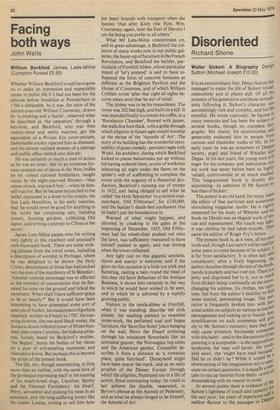Facing both ways
John Wells
William Beckford James Lees-Milne (Compton Russel £5.50)
Whether William Beckford would have gone on to make an impressive and respectable career in public life if it had not been for the episode before breakfast at Powderham in 1784 is debatable. As it was, the tutor of the sixteen-year-old William Courtenay, drawn by 'a creaking and a bustle', observed what he described as 'the operation' through a key-hole, and Beckford, who was then twenty-three and newly married, got the equivalent of a Private Eye cover-picture, fashionable society rejected him as diseased, and his almost realised dreams of a peerage and public office melted into thin air.
He was certainly as much a man of action as he was an artist : heir to an immense fortune sweated out of slaves in the West Indies by his violent colonial forefathers, taught music by the eight-year-old Mozart—'that moon-struck, wayward boy'—when he himself was five. But he became reconciled to the belief, expressed in a letter to his cousin, the first Lady Hamilton, in his early twenties, that 'he would never be good for anything in the world but composing airs, building towers, forming gardens, collecting Old Japan, and writing a journey to China or the moon'.
James Lees-Milne passes over his writing very lightly in this excellent and unusually well-illustrated book. There are some striking phrases from the travel notes, including a description of worship in Portugal, where he was delighted to be shown the Holy Crows, descendants of those that had pecked out the eyes of the murderers of St Benedict : 'Another contrite personage was so affected at the moment of consecration that he flattened his nose on the ground and licked the pavement. When shall I have sufficient grace to be so beastly ?' But it would have been interesting to have attempted some sort of analysis of Vathek, his masterpiece of gothick slapstick, written in French in 1782: the capering dwarves, the one-eyed black mutes, the fantastic doom-infested tower of fifteen hundred steps where Carathis, the hideous priestess, loosely based on Beckford's mother, 'the Begum', burns the bodies of her slaves on a pyre of evil-smelling mummies and rhinoceros horns. But perhaps this is beyond the scope of the present book.
The life, too, though entertaining, is little more than an outline, with the same love of the grotesque expressing itself in the naming of his much-loved dogs, Caroline, Spotty and the Viscount Fartleberry: his dwarf, Perro, unwashed and picking his nose in an armchair, and the long-suffering lovers like his cousin Louisa, writing to tell him how
her heart bounds with transport when she fancies 'that after Kitty (the Hon. Wm. Courtenay, again, later the Earl of Devon) I am the being you prefer to all others.'
What Mr Lees-Milne concentrates on, and to great advantage, is Beckford the collector of many works now in our public galleries, the buyer-up of furniture in the French Revolution, and Beckford the builder, particularly of Fonthill Abbey, whose particular brand of 'let's pretend' is said to have influenced the form of concrete fantasies as different as the Brighton Pavilion and the House of Commons, and of which William Cobbett wrote 'after that sight all sights become mean until that be out of mind'.
The Abbey was to be his mausoleum. The tower was 262 feet high, and built on a hill. It was intended finally to contain his coffin, in a 'Revelation Chamber', floored with jasper, the walls five foot thick, with a grille through which pilgrims in future ages would worship at the shrine of the `Apostle of Art'. The story of its building has the wonderful inevitability of great comedy: petulant rages with Wyatt, his architect, during which Beckford kicked to pieces balustrades put up without his having ordered them, scores of workmen labouring all night under the flares on the spider's web of scaffolding to complete the tower with the urgency of a theatrical production, Beckford's running out of money in 1822, and being obliged to sell what he called 'the Holy Sepulchre' to a retired coalmerchant, 'Old Filthyman', for £330,000, and the builder's death-bed confession that he hadn't put the foundations in.
Warned of what might happen, and alarmed by creaking in the gales at the beginning of December, 1825, Old Filthyman had his wheel-chair pushed out onto the lawn, was sufficiently reassured to have himself pushed in again, and was dozing when the tower collapsed.
Any light cast on this gigantic aesthete, clown and martyr is welcome, and if the glow on this occasion is a little too pink and flattering, casting a halo round the head of this dear old Saint Sebastian of the Antique Business, it shows him certainly in the way in which he would have wished to be seen, and in which he is admired by a rapidly growing public.
Visitors to the mock-abbey at Fonthill, when it was standing, describe the pink plaster, the vaulting painted to resemble ,.stone-work, the perfumed coal and bogus furniture, the 'Save Our Soles' jokes hanging on the wall, Perro the Dwarf pottering through his miniature flowerbeds like an animated gnome, the Norwegian log-cabin and the American garden. Constable describes it from a distance as 'a romantic place, quite fairyland'. Disneyland might have been nearer the mark, and as an early prophet of the Disney Europe through which the pilgrims, frustrated too in a life of action, flood murmuring today, he could at last achieve the double, venerated, in Byron's phrase as the Apostle of Pederasty, and as what he always longed to be himself, the Apostle of Art.


































 Previous page
Previous page